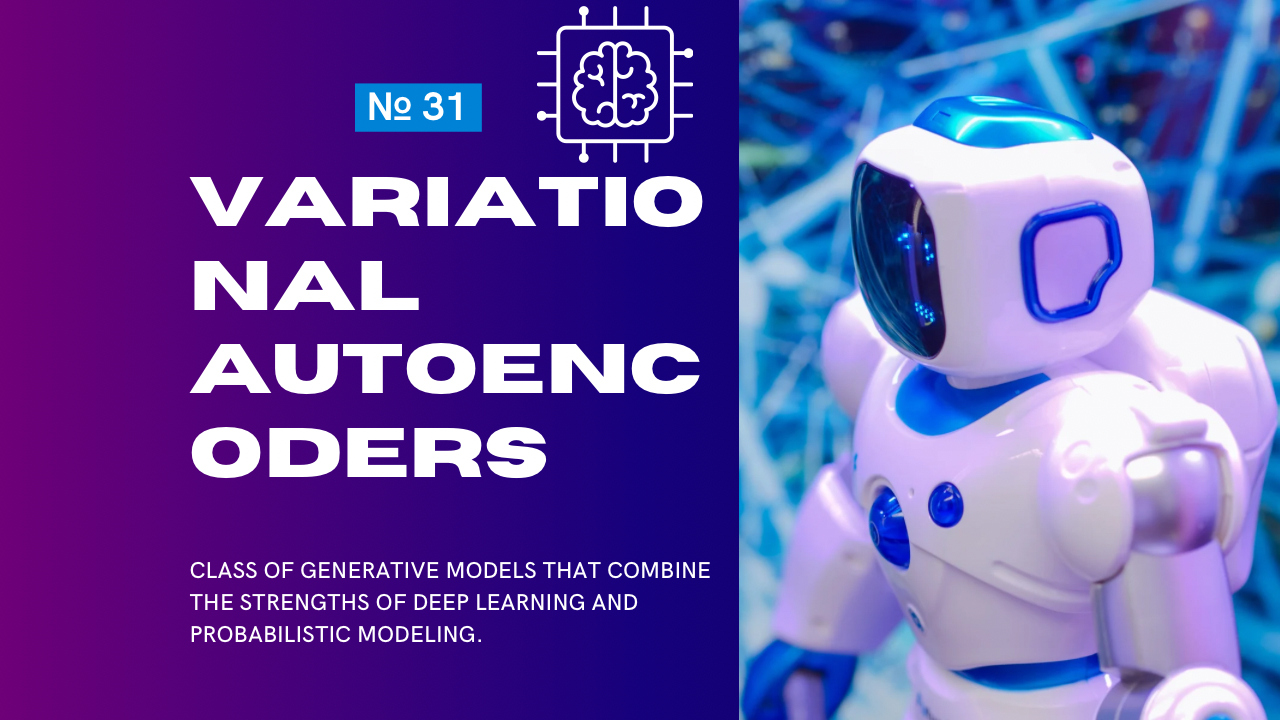Variational Autoencoders (VAEs) are a class of generative models that combine the strengths of deep learning and probabilistic modeling. Unlike traditional autoencoders, VAEs learn a latent representation of data as a probabilistic distribution, enabling the generation of new, diverse samples.
1. What is a Variational Autoencoder (VAE)?
A VAE consists of two primary components:
- Encoder:
- Maps input data to a latent space as a probability distribution (mean ( \mu ) and standard deviation ( \sigma )).
- Outputs a set of parameters that define a latent Gaussian distribution.
- Decoder:
- Reconstructs the input data by sampling from the latent distribution and decoding the samples.
Key Features:
- Latent Space Representation:
- Models the data as a continuous, structured latent space.
- Generative Capability:
- Samples from the latent space can be decoded into new, realistic data points.
- Regularization:
- Encourages smoothness in the latent space using a KL-divergence loss.
2. VAE Loss Function
The VAE loss function combines two terms:
- Reconstruction Loss:
- Measures how well the decoder reconstructs the input data.
- Commonly uses Mean Squared Error (MSE) or Binary Cross-Entropy (BCE).
[
L_{\text{recon}} = \mathbb{E}_{q(z|x)} [\log p(x|z)]
]
- KL-Divergence Loss:
- Regularizes the latent space by ensuring the encoded distribution ( q(z|x) ) is close to a standard normal distribution ( p(z) ).
[
L_{\text{KL}} = D_{\text{KL}}(q(z|x) || p(z))
]
Total Loss:
[
L_{\text{VAE}} = L_{\text{recon}} + \beta L_{\text{KL}}
]
Where ( \beta ) is a weight for the KL-divergence term (as in ( \beta )-VAE).
3. Applications of VAEs in Generative Tasks
| Application | Description | Examples |
|---|---|---|
| Image Generation | Generate new images by sampling from the latent space. | Generating faces, objects, or abstract art. |
| Anomaly Detection | Detect anomalies by measuring reconstruction error. | Fraud detection, industrial defect detection. |
| Data Imputation | Fill in missing data based on learned latent representations. | Completing missing pixels in images. |
| Style Transfer | Modify data by interpolating or manipulating latent representations. | Changing styles of images (e.g., artistic effects). |
| Latent Space Exploration | Understand and visualize high-dimensional data in a compact, interpretable space. | Scientific research, clustering, or dimensionality reduction. |
4. Implementation of VAEs in PyTorch
a. Model Architecture
import torch
import torch.nn as nn
import torch.nn.functional as F
# Encoder
class Encoder(nn.Module):
def __init__(self, input_dim, latent_dim):
super(Encoder, self).__init__()
self.fc1 = nn.Linear(input_dim, 256)
self.fc2_mean = nn.Linear(256, latent_dim) # Mean
self.fc2_logvar = nn.Linear(256, latent_dim) # Log-variance
def forward(self, x):
h = F.relu(self.fc1(x))
mean = self.fc2_mean(h)
logvar = self.fc2_logvar(h)
return mean, logvar
# Decoder
class Decoder(nn.Module):
def __init__(self, latent_dim, output_dim):
super(Decoder, self).__init__()
self.fc1 = nn.Linear(latent_dim, 256)
self.fc2 = nn.Linear(256, output_dim)
def forward(self, z):
h = F.relu(self.fc1(z))
x_recon = torch.sigmoid(self.fc2(h))
return x_recon
# VAE
class VAE(nn.Module):
def __init__(self, input_dim, latent_dim):
super(VAE, self).__init__()
self.encoder = Encoder(input_dim, latent_dim)
self.decoder = Decoder(latent_dim, input_dim)
def reparameterize(self, mean, logvar):
std = torch.exp(0.5 * logvar)
eps = torch.randn_like(std)
return mean + eps * std
def forward(self, x):
mean, logvar = self.encoder(x)
z = self.reparameterize(mean, logvar)
x_recon = self.decoder(z)
return x_recon, mean, logvarb. Loss Function
def vae_loss(x, x_recon, mean, logvar):
# Reconstruction loss
recon_loss = F.binary_cross_entropy(x_recon, x, reduction='sum')
# KL-divergence
kl_loss = -0.5 * torch.sum(1 + logvar - mean.pow(2) - logvar.exp())
return recon_loss + kl_lossc. Training Loop
# Initialize model, optimizer, and data
input_dim = 28 * 28 # For MNIST images
latent_dim = 10
vae = VAE(input_dim, latent_dim).to(device)
optimizer = torch.optim.Adam(vae.parameters(), lr=1e-3)
# Training loop
epochs = 10
for epoch in range(epochs):
vae.train()
train_loss = 0
for x, _ in dataloader: # Assume dataloader is defined
x = x.view(x.size(0), -1).to(device) # Flatten images
optimizer.zero_grad()
x_recon, mean, logvar = vae(x)
loss = vae_loss(x, x_recon, mean, logvar)
loss.backward()
optimizer.step()
train_loss += loss.item()
print(f"Epoch {epoch+1}, Loss: {train_loss / len(dataloader.dataset):.4f}")5. Sampling from the Latent Space
After training, generate new samples by sampling from the latent space:
# Sample from a standard normal distribution
z = torch.randn(16, latent_dim).to(device)
# Decode the latent vectors into data
generated_images = vae.decoder(z).view(-1, 1, 28, 28)
# Visualize the generated images (e.g., with matplotlib)
import matplotlib.pyplot as plt
grid = torchvision.utils.make_grid(generated_images.cpu(), nrow=4)
plt.imshow(grid.permute(1, 2, 0).squeeze(), cmap="gray")
plt.show()6. Extensions of VAEs
a. Conditional VAE (CVAE):
- Generates samples conditioned on labels or attributes.
- Useful for tasks like class-conditioned image generation.
b. β-VAE:
- Introduces a weighting factor ( \beta ) to control the importance of the KL-divergence term.
- Encourages disentangled representations in the latent space.
c. Variants:
- VQ-VAE: Uses discrete latent variables for representation learning.
- Hierarchical VAEs: Uses multiple latent layers for richer representations.
7. Applications of VAEs
Image Generation:
- Generate new images by sampling from the latent space.
Anomaly Detection:
- Measure reconstruction loss to identify anomalies. Anomalous data typically has higher reconstruction error.
Data Augmentation:
- Generate synthetic data to augment training datasets, especially for low-resource tasks.
Latent Space Arithmetic:
- Perform operations like interpolation in the latent space for creative applications (e.g., morphing faces).
Representation Learning:
- Learn meaningful latent features for clustering, classification, or visualization.
8. Advantages and Challenges
Advantages:
- Produces continuous and interpretable latent spaces.
- Ensures diversity in generated samples due to probabilistic modeling.
- Combines generative modeling with regularization for better robustness.
Challenges:
- Requires careful tuning of the KL-divergence weight to balance reconstruction and regularization.
- May produce blurry samples for complex data (e.g., high-resolution images).
- Computationally expensive due to the dual forward pass in the encoder and decoder.
Conclusion
VAEs are a versatile tool for generative tasks, enabling diverse applications like image generation, anomaly detection, and representation learning. By modeling data as distributions in a latent space, they offer flexibility and robustness, especially when combined with extensions like Conditional VAEs or β-VAEs.
